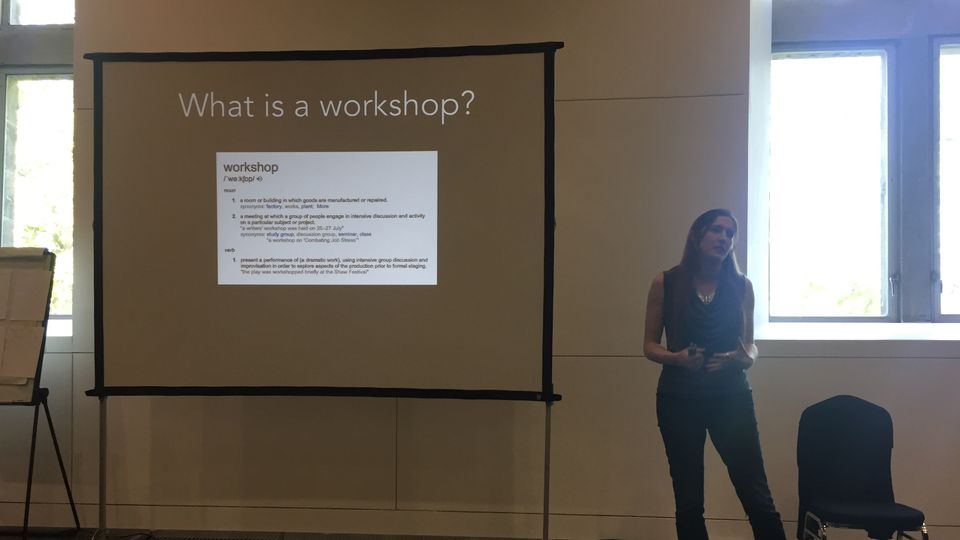Workshop UX

“I’ve never seen anyone queue to do sticker voting before.” Welcome to Blightly, mate. Trans-Atlantic culture shock aside, Darci D Dutcher ran a interactive and informative workshop … about running a workshop (turtles all the way down, anyone?).
As someone who’d carried out the Herculean task of 9 months of twice-daily workshops—”it meant I could quickly try out things and change them if they were wrong”—she had a host of tips, under different categories. And in true eat-your-own-dogfood fashion, she got people to write down questions they had on post-its, then vote on the categories of topics they’d most like to hear about using 2 stickers each. And the last person who put their votes up had to count the votes.
As it turned out, there were clear reasons for doing things like post-it comments and sticker voting – they’re great for encouraging quiet participants to give their point of view, particularly if you tell them upfront that you’ll be collecting the post-its and reading them out so they can be anonymous and not have to say their comments out loud. She also advised that how you allow for voting change depending on the importance of the decision – if it was not overly important, give two votes, if it was very important, give unlimited votes (so that key stakeholders could show all areas they thought important). This was an interesting alternate from the GV system presented the previous day.
And the counting at the end? A nice trick to let the facilitator get on with things “as there’s nothing more boring than watching a facilitator do something while you wait … and it puts pressure on you to get the counting done as fast as you can, which is stressful.”
Some other points I found useful that Dutcher covered were:
- Choosing appropriate activities – she strongly suggested using Gamestorming, Innovation Games, and crowdsourced work games site tastycupcakes.org (yes, the name is real) as references.
- Getting prepared: much like James Altshuler, she suggested forms of preparation rituals such as listening to comedy or disappearing somewhere for a couple of minutes to focus yourself before the workshop “if you’re not focused, the participants will notice” . I’m personally going to make posters as she does about house rules of being respectful, no laptops or phones “unless your wife is 9 months pregnant”, and being present.
- Finding way to help your participants help you facilitate, for example by encouraging them to self-regulate when it comes to behaviours. She recommended a tip from Jeff Patton about having three big paper cups (or signs – thanks Jeff!) on each table that could be picked up to vote a topic as “sold”, “tangent”, or “too much information”. She explained “some quiet people love using this if they’re in a group with their boss” … though when I recounted this story to colleagues afterwards, they were a little more skeptical as to whether this would work with Brits. We’ll see.
- Doing it – fake it till you make it really does work, as psychologists have suggested. Psychologist Amy Cuddy suggests that your body stance affects your perception, meaning that acting powerful will make you powerful (and vice versa for other stances).
- Speaking of psychology, if you’re dealing with a tough audience the symbolic act of offering a gift, no matter how little, can make a big difference. Dutcher told a story of an argumentative group that slowly came to really like her … after she found out about the psychology of offering gifts and started offering tea and biscuits at the start of each meeting.
- Finally, there’s a nice tool from Agile that’s worth using for ongoing meetings – what’s known as a ‘safety check’. It is a signal (usually voted anonymously) at the start of a meeting as to whether people are ready and willing for difficult conversations from 1 meaning ‘my dog died, I’m fragile’ to 5 = awesome. An alternative for workshops, particularly where people may have been sent along by work against their will, is a similar vote to see if they are prisoners, passengers, protestors, or participants.
Member discussion